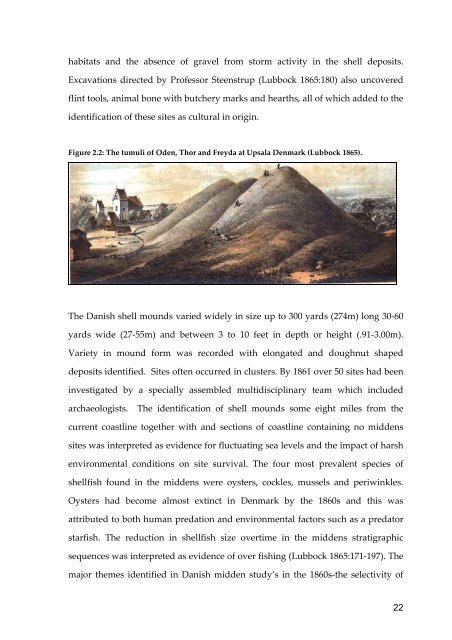One archaeologist's midden is another's shell mound - vanessa ...
One archaeologist's midden is another's shell mound - vanessa ...
One archaeologist's midden is another's shell mound - vanessa ...
Create successful ePaper yourself
Turn your PDF publications into a flip-book with our unique Google optimized e-Paper software.
habitats and the absence of gravel from storm activity in the <strong>shell</strong> deposits.<br />
Excavations directed by Professor Steenstrup (Lubbock 1865:180) also uncovered<br />
flint tools, animal bone with butchery marks and hearths, all of which added to the<br />
identification of these sites as cultural in origin.<br />
Figure 2.2: The tumuli of Oden, Thor and Freyda at Upsala Denmark (Lubbock 1865).<br />
The Dan<strong>is</strong>h <strong>shell</strong> <strong>mound</strong>s varied widely in size up to 300 yards (274m) long 30‐60<br />
yards wide (27‐55m) and between 3 to 10 feet in depth or height (.91‐3.00m).<br />
Variety in <strong>mound</strong> form was recorded with elongated and doughnut shaped<br />
deposits identified. Sites often occurred in clusters. By 1861 over 50 sites had been<br />
investigated by a specially assembled multid<strong>is</strong>ciplinary team which included<br />
archaeolog<strong>is</strong>ts. The identification of <strong>shell</strong> <strong>mound</strong>s some eight miles from the<br />
current coastline together with and sections of coastline containing no <strong>midden</strong>s<br />
sites was interpreted as evidence for fluctuating sea levels and the impact of harsh<br />
environmental conditions on site survival. The four most prevalent species of<br />
<strong>shell</strong>f<strong>is</strong>h found in the <strong>midden</strong>s were oysters, cockles, mussels and periwinkles.<br />
Oysters had become almost extinct in Denmark by the 1860s and th<strong>is</strong> was<br />
attributed to both human predation and environmental factors such as a predator<br />
starf<strong>is</strong>h. The reduction in <strong>shell</strong>f<strong>is</strong>h size overtime in the <strong>midden</strong>s stratigraphic<br />
sequences was interpreted as evidence of over f<strong>is</strong>hing (Lubbock 1865:171‐197). The<br />
major themes identified in Dan<strong>is</strong>h <strong>midden</strong> study’s in the 1860s‐the selectivity of<br />
22


